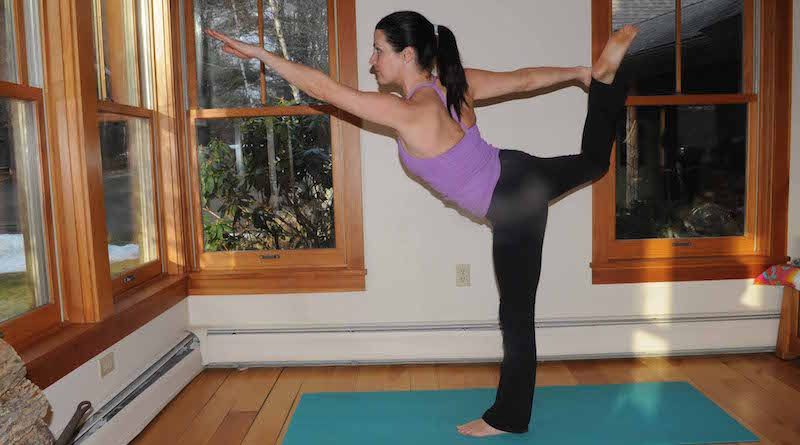10 Essential Yoga Poses for Athletes
If you want to make sure you are ready for spring, make these yoga poses part of your winter training.
By Beth Bowen
If you are running, cycling or skiing regularly you know that repetitive motions in one plane of motion can lead to tightness, muscle imbalance and eventually injury if you are not careful.
Yoga is not only the ideal counter balance to that, it can actually enhance your performance in a variety of sports if you do it correctly. In my practice as a physical therapist and a yoga teacher, I work with runners and cyclists and often recommend these poses to help improve flexibility, strength and balance in areas that tend to break down and get injured with cumulative training.
I highly recommend taking a class to get trained instruction in these poses. A yoga instructor will offer cues for proper alignment in poses, which will help to prevent injury.
Open Your Hips
Too often we think of our legs as the powerhouses when it comes to running, cycling and skiing. They may be the engines that propel us, but our hip flexors and gluteals are the links to the rest of the body and they can put on the brakes. If they are not strong and flexible, you won’t get the maximum performance. The following poses can help loosen these areas and make your stride or pedal stroke more efficient.
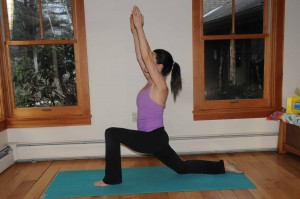
- Low Lunge Pose (Anjaneyasana): The ability to slowly lower down into a lunge position with proper knee alignment requires eccentric quadriceps control—something that is required during the landing phase of running. In Low Lunge, this half-kneeling position not only allows for the back leg’s hip flexor muscle group to stretch but it also recruits the stabilizers in your hips and core to hold this position.
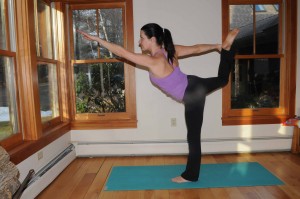
- Dancer’s Pose (Natarajasana): Whether you are trail running or jumping a curb, you know how easy it is to lose your balance. This pose, which has you balancing on a single leg, works your dynamic balance as you start with a standing quad stretch and then fold forward slightly. It also allows for a hip flexor and quad stretch in the rear leg.
Keep Your Glutes and Hamstrings Flexible
Keeping your glutes and hamstrings flexible flexible is very important as the miles accumulate. If you don’t work these muscles you’ll find yourself stiff and it will be harder to bend over.
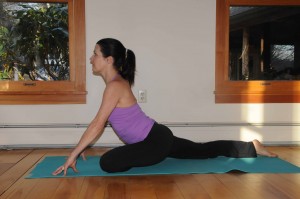
- Pigeon Pose (Eka Pada Raj Kapotanasana): This pose allows for a deep stretch to the front leg’s hip rotators and gluteals—both of which are recruited to stabilize the pelvis and hips while you run. In addition, the rear leg hip flexors are stretched. Be careful, though: if you don’t do this pose correctly there is a risk of straining the sacroiliac joints (SIJ) and the sciatic nerve. To avoid a strain, take caution to keep the sacrum level and don’t allow one buttock to drop lower than the other. Be careful, too, not to force this pose or you may irritate the sciatic nerve. bringing the knee less horizontal will ease strain on the knee.
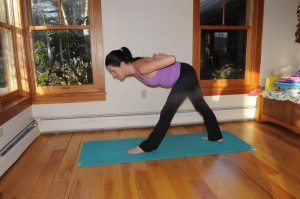
- Bowing warrior (Parsvottanasana): This standing folded pose in a split stance allows for a more intense stretch in the hamstrings. Take caution to avoid damage by softening or bending the knees (especially front) to avoid too much of a stretch. The ability to hinge at the hips and slowly fold forward into this bowing warrior pose demands eccentric hamstring control which is also required in running and cycling.
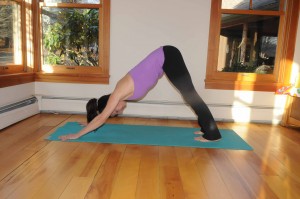
- Downward Facing Dog (Adho Mukha Svanasana): An inverted triangle pose, this helps lengthen the entire spine and stretches the calves, hamstrings and paraspinals (the long muscles that run parallel to the spine). By keeping active arms and legs in this pose, you will also use the stabilizers of the shoulder and shoulder blades (scapula). Paying attention to hand and feet position: keep your hands a feet a hips-width apart, spread your fingers and toes and keep a slight bend in the elbows and knees. In this pose your shoulders must flex forward similar to the way you reach forward to the handlebars or aero bars on a bike.
Strengthen Your Core
Think of your core as the hinge that holds your body together. As your legs strengthen with running or cycling, the rest of your body needs to catch up or you are likely to put strain on your lower back. These poses help strengthen both the core abdominal muscles and your upper body as well.
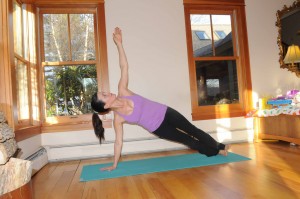
- Side Plank Pose (Vasisthasana): A one-arm balance pose works the core and adds to total body strength. This pose requires a lot of stabilizing action in the abdominal and thoracic (middle spine) musculature. If you hold this position properly, it requires less effort.
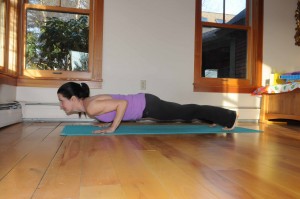
- Plank (Phalakasana into Chattaranga Dandasana): Plank pose is a core and total body strength pose that also requires attention to alignment from head to toe for optimal efficiency. Moving into Chattaranga Dandasana is the lowering phase of a push up with elbows hugging in towards the sides of the body. It is excellent for upper body strength, which is key to add to both running and cycling training schedules. If your upper body isn’t strong enough to handle this pose properly then modifying it by lowering your knees and chest will help to avoid excessive strain to the shoulder and neck regions. This pose can help to strengthen the muscles you use to maintain proper trunk alignment on the saddle in cycling.
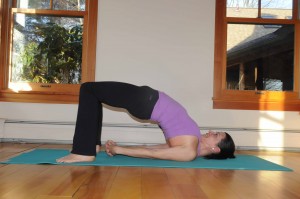
- Bridge Pose (Setu Bandha Sarvangasana): Lying on your back, this pose is a great to strengthen the hamstring, glutes and core while lengthening the muscles through the front body (abdominals, hip flexors and quads). Adding dynamic movements to the arms and legs while keeping a steady lifted bridge can help to strengthen the pelvic core. Working against gravity, you extend your hips upward, which will strengthen the hips for extension required in both running and cycling.
Keep Your Spine Aligned
One of the most common complaints runners and cyclists often have is back pain. That’s because we don’t stretch and work the back muscles the same way we do our legs. These poses build strength and flexibility that will help keep your spine aligned.
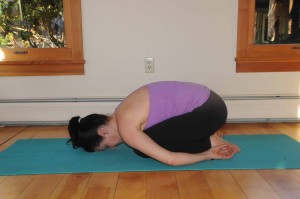
- Child’s Pose (Balasana): Folding forward while on all fours allows the spine to move into a long flexion curve, lengthening the erector spinae muscles that run lengthwise down adjacent to the spine. It also requires the knees, hips and spine to flex. Take caution not to force through any pain when attempting to get into this pose. Props may be necessary under the front of the ankles or behind the thighs if there is cramping or restriction. This pose is a good hip flexor mobility exercise. Having adequate hip flexion is required for the top part the pedal stroke and allows for smooth fluid cadence without having to strain the muscles in the lumbar spine (low back). This is a good pose to check for hip flexor mobility as you add on the miles and intensity in your training routine. You will notice that it is more difficult to get the hips to the heels after a hard workout and it is a good pose to do on the day after a race for recovery.
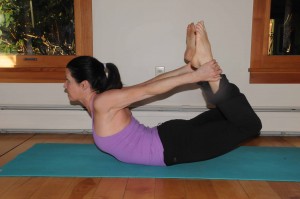
- Bow Pose (Dhanurasana): Lying on your belly, this pose allows the front of the hips, thighs, chest and biceps to lengthen while engaging the back’s spinal extensors, hip extensors, shoulder extensors and shoulder blade retractors. Bow pose is a nice counter pose to the roundedness that happens from both cumulative miles sitting on the saddle of your bike or sitting at a desk all day. This pose allows for the hips and spine to extend by engaging the largest muscle group (gluteals) which is important to keep strong for the powerful cycling stroke required to go uphill.
Practice Breathing and Relaxing
Lastly, yoga is a discipline where the connection between movement and breath is crucial. Your diaphragm is one of the strongest muscles in the body and the primary one in inhalation. Practicing and learning how to use it to breathe is key to maximizing performance and increasing your VO2 max. It is also important in releasing tension/stress.
When you are stressed, there is a tendency to take shallow breaths (which uses the neck and chest muscles) and the breath doesn’t fill your lungs completely. Practicing diaphragmatic breathing during yoga will have carry over to your sport.
In general, in yoga poses where you fold or lower your body you exhale, and when you rise up or lengthen, you inhale. By familiarizing yourself with this connection of breath to movement during poses, you can use the breath to help during running or cycling or any physical activity.
To practice while running or cycling, think about timing your breath to your stride or cadence. Create a rhythm that connects movement of breath with a constant flow of energy. Work on improving your awareness of how you are breathing so you become aware if you are holding your breath or taking short breaths. After all, breath is essential to life.
A former alpine ski racer, soccer player and now a cyclist and runner, Beth Bowen, MS PT, earned her masters of science in physical therapy from Regis University in Denver, Colo. She has been practicing for 18 years and currently works at Appletree Bay Physical Therapy. She is also a certified 200-hour yoga teacher who works at and is currently teaching Yoga for Runners at Green Mountain Rehabilitation and Sports Medicine in Burlington, on Monday nights 6:15-7:15.

